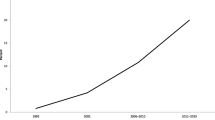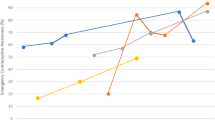Abstract
Emergency contraception (EC), including both emergency contraceptive pills and the intrauterine device (IUD) used post-coitally, is a unique part of the contraceptive method mix. Clinicians still have an important role to play in making EC information and services available, even though one EC method is available without a prescription in the US and a number of other countries around the world. Women need accurate information about EC in general, and about the specific options that may be most effective for them, including ulipristal acetate and the IUD. Given confusing media messages about EC and weight and unclear clinical guidance, clinicians may wish to pro-actively raise EC in routine clinical encounters. They can also take part in ensuring that EC is offered to women who are receiving treatment after sexual assault.
Similar content being viewed by others
References
Papers of particular interest, published recently, have been highlighted as: • Of importance
International Consortium for Emergency Contraception. Status and Availability Database. 2014. http://www.cecinfo.org/country-by-country-information/status-availability-database/
Palermo T. Factors associated with knowledge and use of emergency contraception: A global analysis. Presentation at the American Public Health Association meeting, Boston, MA. November 5, 2013
Singh S, Sedgh G, Hussain R. Unintended Pregnancy: Worldwide Levels, Trends, and Outcomes. Stud Fam Plan. 2010;41(4):241–50.
Lundsberg L, Pal L, Gariepy A, Xu X, Chu M, Illuzzi J. Knowledge, attitudes, and practices regarding conception and fertility: a population-based survey among reproductive-age United States women. Fertil Steril. 2014. doi:10.1016/j.fertnstert.2013.12.006.
International Consortium for Emergency Contraception and International Federation of Gynecology and Obstetrics. Mechanism of Action: How do levonorgestrel-only emergency contraceptive pills (LNG ECPs) prevent pregnancy? March 2012.
Glasier A, Cameron ST, Blithe D, Scherrer B, Mathe H, Levy D, et al. Can we identify women at risk of pregnancy despite using emergency contraception? Data from randomized trials of ulipristal acetate and levonorgestrel. Contraception. 2011;84(4):363–7. Glasier et al., report on the efficacy of ulipristal acetate (UPA) EC and levonorgestrel (LNG) EC. They find that obese women taking either method have a risk of pregnancy more than three times greater than the risk for women with normal body mass index, and that for obese women the risk of pregnancy was greater with LNG than UPA. They also found that women who had unprotected intercourse after using either type of EC were more likely to get pregnant than those who did not.
Jones J, Mosher W, Daniels K. Current Contraceptive Use in the United States, 2006–2010, and Changes in Patterns of Use Since 1995. National Health Statistics Reports. U.S. Department of Health and Human Services. October 2012.
Secura GM, Allsworth JE, Madden T, Peipert JF. The Contraceptive CHOICE Project: reducing barriers to long-acting reversible contraception. Am J Obstet Gynecol. 2010;203(2):115.e1-7.
Turok D, Gurtcheff S, Handley E, Simonsen S, Sok C, North R, et al. A survey of women obtaining emergency contraception: are they interested in using the copper IUD? Contraception. 2011;83(5):441–6. Turok et al., surveyed women presenting for EC at family planning clinics in urban Utah to learn whether they would be interested in using the copper IUD for EC. They found that approximately 12 % of women reported they would be interested in and willing to pay for IUD insertion.
Schwarz E, Kavanaugh M, Douglas E, Dubowitz T, Creinin M. Interest in Intrauterine Contraception Among Seekers of Emergency Contraception and Pregnancy Testing. Obstet Gynecol. 2009;113(4):833–9.
Turok D, Gurtcheff SE, Handley E, Simonsen SE, Sok C, Murphy P. A pilot study of the Copper T380A IUD and oral levonorgestrel for emergency contraception. Contraception. 2010;82(6):520–5.
Wu S, Godfrey EM, Wojdyla D, Dong J, Cong J, Wang C, et al. Copper T380A intrauterine device for emergency contraception: a prospective, multicenter, cohort clinical trial. BJOG. 2010;117(110):1205–10.
Piaggio G, Kapp N, von Hertzen H. Effect on pregnancy rates of the delay in administration of levonorgestrel for emergency contraception: a combined analysis of four WHO trials. Contraception. 2011;84(1):35–9. Piaggio et al., analyze the effectiveness of levonorgestrel EC administered at different points in time after unprotected sex, up to five days. They find increased risk of pregnancy when LNG EC is delayed until the fifth day and conclude that it is uncertain whether it still offers protection against unwanted pregnancy at this point.
Glasier AF, Cameron ST, Fine PM, Logan SJ, Casale W, Van Horn J, et al. Ulipristal acetate versus levonorgestrel for emergency contraception: a randomized non-inferiority trial and meta-analysis. Lancet. 2010;375(9714):555–62.
Fine P, Mathe H, Ginde S, Cullins V, Morfesis J, Gainer E. Ulipristal acetate taken 48–120 hours after intercourse for emergency contraception. Obstet Gynecol. 2010;115(2 Pt 1):257–63.
Irish Medicines Board. Package Leaflet: Information for the User. NorLevo 1.5 mg tablet. November 2013. http://www.imb.ie/images/uploaded/swedocuments/2126041.PA1166_001_001.30ddd85e-0627-4862-9543-3254d38fbf9e.000001PACKAGE%20LEAFLET%20750.131128.pdf.
Frayar CD, Gu Q, Ogden CL. Anthropometric reference data for children and adults: United States, 2007–2010. National Center for Health Statistics. 2012. Vital Health Stat. 11(252).
Kahn C. Following Bloomberg’s Lead, Mexico Aims to Fight Fat. National Public Radio. October 24, 2013. http://www.npr.org/blogs/parallels/2013/10/24/240340885/following-bloombergs-lead-mexico-aims-to-fight-fat.
Keding G, Msuya J, Maass B, Krawinkel M. Obesity as a public health problem among adult women in rural Tanzania. Glob Heal Sci Pract. 2013;1(3):359–71.
European Medicines Agency Press Office. Review of emergency contraceptives started. Press release. January 24, 2014.
World Health Organization. Emergency contraception fact sheet No. 244. July 2012 (http://www.who.int/mediacentre/factsheets/fs244/en/index.html, accessed 5 February 2013).
Halpern V, Raymond EG, Lopez LM. Repeated use of pre- and post-coital hormonal contraception for prevention of pregnancy. Cochrane Database Syst Rev. 2010;1, CD007595.
Patel A, Roston A, Tilmon S, Patel D, Roston A, Keith L. Assessing the extent of provision of comprehensive medical care management for female sexual assault patients in US hospital emergency departments. Int J Gynaecol Obstet. 2013;123(1):24–8.
Patel A, Tilmon S, Bhogireddy V, Chor J, Patel D, Keith L. Emergency contraception after sexual assault: changes in provision from 2004–2009. J Reprod Med. 2012;57(3–4):98–104.
Sohaba N, Mullick S, Van Blerk L, Khoza D. Evaluation of Post Rape Care Services for Children in Limpopo and North West Provinces. Presented at the XIX International AIDS Conference, Washington, D.C., July 22, 2012.
Keesbury J, Onyango-Ouma W, Undie C, Maternowska C, Mugisha F, Kageha E, et al. Review and Evaluation of Multi-Sectoral Response Services (“One-Stop Centers”) for Gender-Based Violence in Kenya and Zambia. Nairobi: Population Council; 2012.
U.S. Department of Justice Office on Violence Against Women. A National Protocol for Sexual Assault Medical Forensic Examinations, Adults/Adolescents. Second Edition. April 2013.
Compliance with Ethics Guidelines
Conflict of Interest
Elizabeth Westley, Sarah Rich, and Hilary Lawton declare that they have no conflict of interest
Human and Animal Rights and Informed Consent
This article does not contain any studies with human or animal subjects performed by any of the authors.
Author information
Authors and Affiliations
Corresponding author
Additional information
ICEC receives support from several pharmaceutical companies for annual meetings, translations, and events at conferences. In the last three years, ICEC has received this support from Actavis, Gedeon Richter, HRA Pharma, and Teva.
Rights and permissions
About this article
Cite this article
Westley, E., Rich, S. & Lawton, H. New Research in Emergency and Postcoital Contraception. Curr Obstet Gynecol Rep 3, 150–154 (2014). https://doi.org/10.1007/s13669-014-0079-6
Published:
Issue Date:
DOI: https://doi.org/10.1007/s13669-014-0079-6




